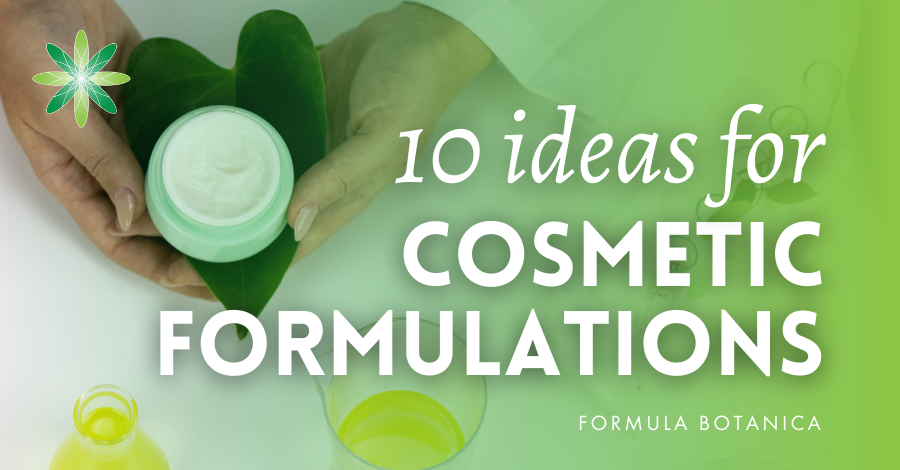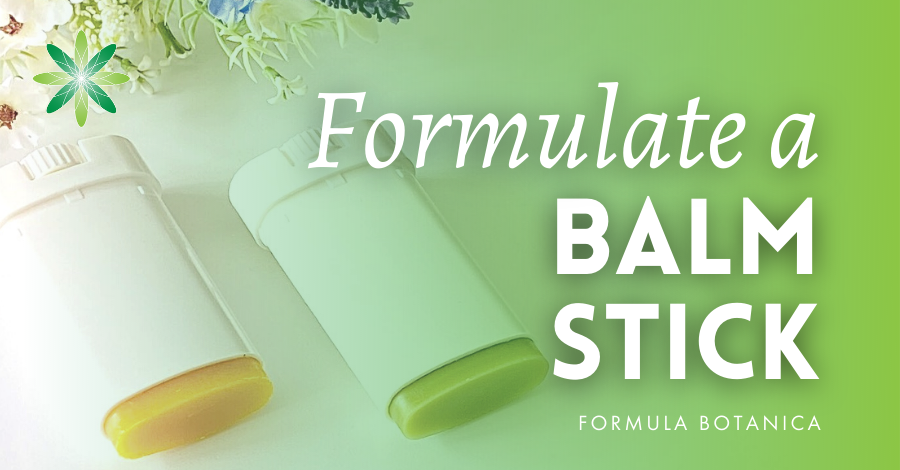You will know from your own experiments that natural cosmetic formulation is a creative outlet and gives you the opportunity to combine science and nature. It is incredibly empowering when you formulate your own botanical cleansers, serums, shampoos or lotions.
The sheer pace of change we see in new natural ingredients and innovative product types on the market is proof enough that our sector is unstoppable and offers the natural formulator immense creative scope.
In this post, we have 10 ideas to help you find inspiration for your cosmetic formulations. Among them, you may find one to make your own and develop into a fabulous new, efficacious formulation – whether for yourself, your family and friends or to build into a business proposition.
For more formulation ideas, see our interviews with Formula Botanica tutors. They share how they research new product formulations. Browse also our graduate gallery of indie beauty founders to see the range of ideas that fostered their brands. First, let’s recap on how two beauty entrepreneurs we interviewed on our Green Beauty Conversations’ podcast found their inspiration.
Tips from inspirational beauty entrepreneurs
Sarah Brown, the founder of Pai Skincare, built her company as a fiercely organic skincare brand out of a personal need to help alleviate her own skin condition and to help others with sensitive skin issues.
Drawing on your own skin needs is an ideal place to start thinking about a new product especially when you are a beginner formulator.
In another podcast episode, Formula Botanica graduate Sandra Velasquez, the founder of Nopalera, says her inspiration was her vision of a brand that would change consumer perceptions of Mexican-heritage goods. Sandra’s product line is dedicated to Mexican ingredients and her Latino roots. She had a clear mission for Nopalera even before she started thinking of products.
These entrepreneurial founders show how two very different paths inspired their beauty brands and products. You may need to dig deep to find just the right direction for your cosmetics formulations, but help is at hand.
10 ideas to inspire cosmetic formulations
Before you start
At Formula Botanica, we encourage our students to be aware when planning a new formulation of a cosmetic product’s afterlife. How will it be disposed of while in use and also when past its shelf life? How will your formulation impact the planet and how can you formulate with sustainability in mind? Can it be packaged to reduce waste?
These points apply to any formulation you plan. In fact, you may discover that the afterlife of a formulation and reducing its carbon footprint in manufacture – through, for instance, using cold processes only – become driving forces behind your new cosmetic formulations.
Need some inspiration for your cosmetic formulations? This @FormulaBotanica guide has 10 ideas to get you formulating fabulous new cosmetic products. #naturalformulation #indiebeauty #greenbeauty Share on X1. Your own or family/friends’ skincare or haircare issues
As we mentioned in the example of Pai Skincare, your own, and your friends’ and family’s skin or haircare issues are a very practical place to get product inspiration. On one our Clubhouse chats, someone said they just look in the mirror to see what their issues are and take it from there.
Think about when you last took a long hard look at your skin or hair condition or thought about them as a cosmetic formulator would? If you put your formulator’s hat on and assess even one issue, you have hours of research in front of you. What priority issues need addressing and what is your desired outcome? Which natural ingredients might counteract the problem?
Will other people have the same issues and will your cosmetic formulations fill a gap in the market? If you are formulating for a common enough skin or hair issue, then how can you differentiate your formulation? Perhaps focus on a specific ingredient, or how the product will be applied or used differently from others in that niche. Think of multifunctional products that can reduce our need to buy more. Can a night serum contain essential oils that can be sensorial for nighttime as well as have skin-beneficial properties?
Getting to grips with a skin or haircare issue you experience first hand is a good place to start to learn about the process of cosmetic formulation.
2. Market trends
Cosmetic formulations are nothing without context. Is there a market for your idea, will beauty consumers recognise its need or be eager to find out about your product?
As a natural cosmetic formulator, you need to keep updated with the beauty industry, its trends, new terms and favoured ingredients. However, we advise you to think carefully before basing a new business range on a single trending ingredient. This is because it is likely to be superseded in a year by the next trending botanical extract.
It is a juggling act to remain relevant but not tied to trends. As an indie formulator, you are well placed to put your own stamp or brand personality on a new formulation. Of course, use for example bakuchiol or AHA/BHAs if they suit your formulation concept, but understand that basing a range on a trending ingredient might make for short-lived success.
It is far better to think about longer-term, ongoing trends such as the push for sustainable beauty, refillable beauty, multipurpose beauty and minimalist skincare and formulate to be part of this conversation, which is not going away. The beauty media flits from one new, wonder ingredient to the next and it can be costly for small indie brands who buy certain minimum quantities of ingredients, to adopt and formulate with new ingredients quickly.
3. Star ingredients
A star ingredient is not necessarily the same as a trending ingredient. Your star ingredient must have meaning for you, the type of formulations you wish to make and be effective for your product users.
Sandra Velasquez’s Nopalera range uses extracts of the native Mexican Nopal cactus (also known as prickly pear or Opuntia ficus indica). The cactus is her star ingredient and defines Nopalera from its name to its branding and marketing. While Sandra’s Mexican heritage guided her to the Nopal, you may simply be curious about an ingredient such as seaweed, chia seeds or oats.
Launched by graduate Roshanne Dorsett in the UK, The Glowcery skincare brand uses antioxidant-rich superfoods in its line and looks for its formulation inspiration to the regular, everyday fruit, vegetables, nuts and seeds you would find in a typical greengrocers or supermarket.
Before diving headlong into a star ingredient, do your research to see how it functions and what cosmetic products it best suits. What types of botanical extracts – and actives – does it contain? Are they water or oil soluble, or does the plant provide both? Can you obtain it easily, is it within budget and does it require specific ingredients to accompany it in a formulation or any special handling or storing? Does it have a defining odour or colour?
Use reliable online sources to research your potential star ingredient and see if you can obtain samples from manufacturers and suppliers. Try portals such as UL prospector and Covalo, and read up on supplier sites. If you are a Formula Botanica student, you have access to our recommended supplier list. We also list some suppliers after each formulation on this site.
4. Sustainable or upcycled ingredients
Sustainable and upcycled ingredients may be trending, but they are not going away. With climate change concerns now rising up the agenda of the beauty industry and brands, both large and indie, seeking to mitigate their own damaging impact on the planet, sustainable cosmetic formulations are the future.
Our Green Beauty Conversation episode with Upcircle Beauty co-founder Anna Brightman shows it is possible to build a global beauty brand on the back of upcycled food and drink industry by-products and waste. Products with sustainability built in are the way forward for the creative formulator and beauty brand founder.
The opportunities are limitless and the rewards can be great, but as a formulator, you will need to be passionate and dedicated to the mission of creating more sustainable cosmetics; and to educating your consumer especially if your product type or packaging are different from those they are used to. As you will hear from Anna, it takes a lot of research, trial and error and false starts to attain the ideal sustainable beauty product. We believe that sustainable cosmetic formulation should be the only way beauty products are conceived.
5. Athleisure, sports and lifestyle
The pandemic has forced a great many of us to remain at home and as a result, we are not only wearing leisurewear for routine sport and exercise but also as our regular daytime gear. Even before the pandemic, this blurring of home life and work had an impact on beauty and fashion.
Image-based search platform Pinterest predicts in its 2022 report that we will be looking for slow, mellow exercise routine ideas rather than engaging in high-energy intensive workouts or sports.
Out with the high-performance natural deodorants and in with cosmetics that are relaxing and sensory to use? Perhaps not, but keep an eye on trends. The Pinterest Predicts report shows the trending search term ‘simple dance moves’ was up 150 percent, while search for ‘lazy workout in bed’ was up 135 percent and ‘walking in nature’ was up 95 percent over the past year.
These statistics are a source of inspiration for the formulator seeking to devise products in line with our lifestyles. But, look also at your own lifestyle for ideas. Our graduate Moira Newiss in Scotland created her brand Skirr as a sustainable skincare brand for eco-conscious adventure and endurance athletes who are looking for products to address sport-specific problems.
If you think about what type of leisure, exercise and sports people are taking to, you may well have new cosmetic formulations to meet their needs or that resonate with their lifestyle.
6. Cooking and cuisines
There are many analogies between cooking and cosmetic formulation. At Formula Botanica, we stress that natural formulation is a skill anyone can learn and enjoy and that it is very much like cooking. When you make mayonnaise or thicken a sauce, you are using techniques and applying much the same science as you would in making skincare emulsions or adding gums and rheology agents to your formulations.
Technical aspects aside, cooking and cuisines are a limitless source of inspiration for formulators thanks to their use of spices, herbs and other aromas and also in how they make us feel. A dish can be comforting, nourishing, refreshing and so on. A cool homemade lemonade may inspire a refreshing facial toner; a creamy dessert laced with vanilla might inspire an indulgent whipped body butter.
Formula Botanica graduate Karmen Novak launched her brand Flower & Spice after being inspired to research how the herbs and spices she loved using in cooking might have benefits for the skin. Other graduates in our gallery also refer to their love of cooking and regional cuisines as a starting point for their formulation journeys.
7. Fragrance or fragrance-free
Fragrance in cosmetics has been a divisive topic for many years. For example, our podcast with conservationist and skincare brand founder Dr Sally Gouldstone tackles the topic of essential oil sustainability.
The Lab at Formula Botanica, our CPD membership site, dedicated a whole month’s training to understanding and formulating for sensitive skin. Interestingly, perfume sales boomed during the pandemic as people wanted a small luxury to indulge in.
If using fragrance or fragrance-free as a core part of your messaging, you will need to explain the benefits of your formulating decision and think about whom you are targeting. Our graduate Lucia Mencarelli purposely created her successful skincare line Casa Mencarelli without any essential oils or added fragrancing ingredients.
You may like to include scent in your cosmetic products but also wish to formulate for sensitive skin. Fragrance may also included in formulations to mask undesirable scents of other ingredients. Some botanical butters and oils can have characteristic nutty or seedy scents.
Fragranced and fragrance-free cosmetics are still topical, exciting spaces to explore and inspire your formulations.
8. Holidays and the seasons
Among the formulations on this site, we include several that are inspired by the seasons and by opportunities to gift skincare on special occasions. Holidays, celebration days and the seasons are fun focal points to inspire your cosmetic formulations. They are ideal starting points for the beginner formulator and anyone wishing to give a personal and personalised skincare gift.
Holidays can inspire scents, the use of herbs and spices, and of course the product’s function. The seasons bring with them a need for a skincare routine change as our video post Top 10 winter skincare tips shows.
We feature some interesting organic gift set ideas created by five Formula Botanica graduates who run their own indie beauty brands. They give their tips on how to plan and budget for seasonal gift sets in a beauty product range and advice on how to exploit seasonal opportunities to gain customers all year round. Gift sizes and sets often double up as offers, samples and starter sets for customers at other times of year. Formulating for the seasons and holidays is as much to do with packaging and presentation as what is in the product itself.
9. Decide on a product type
Form and function go hand in hand in cosmetic formulation. Certain product types are best suited to delivering certain cosmetic benefits. So, start by deciding on the type of product that can deliver the skin or haircare results you want to achieve.
You may simply love making emulsions or have a passion for formulating balms or creating jewel-like glycerites. Doing what you love most is a good place to start. Later, challenge yourself to get out of your comfort zone and learn to formulate product types that demand different skills or more expertise.
At Formula Botanica, we often advise our students to start with anhydrous products such as facial oils and balms. These cosmetic formulations can be made cheaply with just a few, readily-available ingredients.
But even these products can take time to formulate as desired. You need to juggle the ratios of oils and butter to reach the right consistency for balms and play around with oils to create products that suit different skin issues and types. Take a look at our anhydrous formulations for a lip balm and a lip serum: note the different styles of formulation which are created for different lip care reasons.
Emulsions meanwhile lend themselves to the inclusion of more high-performance active ingredients such as retinoids and AHAs that are designed to target specific skin needs.
As you can see, one product type alone can inspire weeks of formulating time as you explore all that a certain product type has to offer. We have graduates who have successfully launched their indie beauty businesses on the back of a hero product type – such as anhydrous oils and balms or dry, water-activated formulations. Graduate brand Õrn Kuu focuses on high-quality, anhydrous formulations in sustainable, minimal yet beautiful packaging.
10. Climate, culture and environment
With our over 15,000 students and graduates spanning over 180 countries, we have seen cosmetic formulations inspired by just about every climate and natural habitat. From arctic landscapes and the wild forests of Canada to Mongolia and Morocco, our community has explored native botanicals and their applications in cosmetics.
Levering on your own region’s botanical bounty is one clear way to give your formulations a distinct personality. Geography can be a unique selling point for an indie brand, be a talking point for a founder story and define a cosmetics’ range.
Everyone, whether living in a town, city or the countryside can find immediate ideas for formulations just outside their door. Corsican immortelle herb, Mexican Nopal cacti, arctic kelp, Australian bush plants, and traditional Russian ice therapy are just a few examples of geography and history having inspired cosmetics.
Think of skin and hair issues that might arise from the environment you live in, and not only about how to use native botanical ingredients. Indie beauty brand Osco was created by our graduate and former nurse Coryan Cheung in Hong Kong as an anti-pollution skincare brand.
Just head to our graduate gallery, which is organised by continent, and be inspired about the potential for your own cosmetics formulation.
Leave us a comment

Liz was Formula Botanica’s Content Coordinator between August 2020-2024. Liz worked as a professional blogger, journalist and site developer for many years and was also part of the Formula Botanica student community. Read more about the Formula Botanica Team.




































